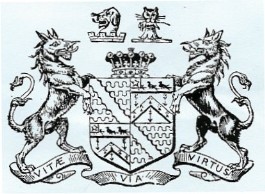Earls of Portarlington Coat of Arms
"Vitae via Virtus" =Virtue is the way of life.
FRONT OF HOUSE FACADE
TYMPANUM
The tympanum is the triangular shape over the porch.
THE COAT OF ARMS OF THE DAWSON-DAMER FAMILY

Originally, a coat of arms was devised
in the early Middle Ages because a man in full armour for battle was unrecognisable,
so each man wore a distinctive coat, by which he could be recognised, over
his armour – his “coat of arms”.
A coat of arms is frequently depicted on a shield but may also include other
decoration around the shield, as in the case of the coat of arms over the
porch at Emo Court.
The coat of arms of any family is unique to that family.
Illustration here
The coat of arms of the Dawson-Damer
family represents both the Dawson and the Damer families. The shield is divided
into four quarters, with the top right and the bottom left representing the
Dawson family, and the top left and bottom right the Damer family.
The heraldic tigers on the left and right of the shield are called ‘supporters’,
and are generally only seen in a peer’s coat of arms or that of royalty.
The open coronet over the shield is also only used by a peer.
The motto underneath the shield is frequently written in Latin: here the motto
of the Dawson-Damer family is Vitae Via Virtus, or, in English, Virtue is
the Path of Life????
A coat of arms will often include a personal crest, or small decoration, over
the top of the coronet or shield. The crest of the Dawson family is a cat’s
head holding a rat in its mouth. The crest of the Damer family is a dog’s
head rising out of a crown. Neither of these appears over the coat of arms
at Emo Court.
Underneath the coat of arms is the date, written in Roman numerals, of the
building of the house: MDCCXCVI (1796).
In front of the house at the steps, there are two heraldic tigers holding
the Dawson quarter of the coat of arms. These stress the importance and status
of the family.
Heraldry
Coats of arms are in a very long tradition of symbolising men and communities
in a pictorial fashion. The organisation of the symbols and colours in coats
of arms is called heraldry. In England and Scotland many families have a historical
coat of arms and many Americans are interested in acquiring one and therefore
the Office of the College of Arms in London is very busy. In Ireland the Office
of Arms is part of the National Library of Ireland and is called the Genealogical
Service.
As the use of arms developed, heralds evolved practical conventions governing
the design and arrangement of coats of arms. Only five colours are generally
used, and these have special names: red (gules), blue (azure), black (sable),
green (vert), and purple (purpure). Yellow (or) and white (argent) –
the metals gold and silver - are also used, and a number of furs including
ermine.
There is a special language to describe all the different designs and patterns
that can be on a shield – this language is called ‘Blazon’.
This is the official description in Burke’s Peerage and Baronetage of the Dawson-Damer coat of arms in Blazon terms:
The names of the colours are shortened in the official description. Can you say what colours are used in the Dawson-Damer coat of arms?
Quarterly: 1 and 4, DAMER: barry nebuly of six arg. and gu. over all a bend engrailed, az; 2 and 3, DAWSON: az., a chevron erm., between three arrows paleways points downwards,arg.; on a chief of the last three martlets sa.: a canton gu., charged with a mullet gold. Supporters – two heraldic tigers.
Translation aids - Blazon to English:
Barry = division
Nebuly = wavy
Bend = diagonal band or stripe
Engrailed = with a serrated edge
Chevron = arrowhead shape
Paleways = vertical
Chief = horizontal strip at top of shield
Martlet = heraldic bird
Canton = small square
Mullet = five-pointed star
Can you find any other examples of coats of arms? (Laois County Council, Laois GAA, your favourite football team, the Queen of England, etc)
Design your own coat of arms.
www.heraldry.ws